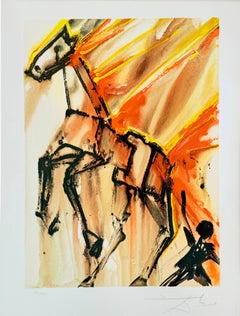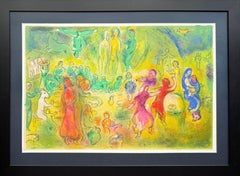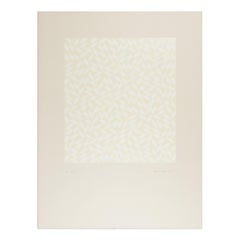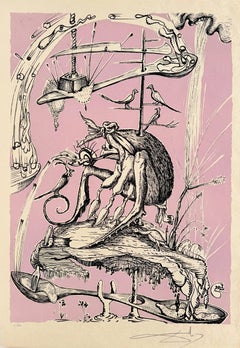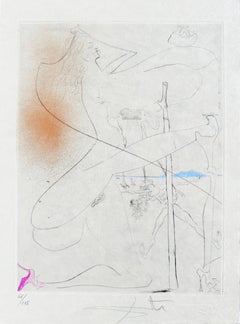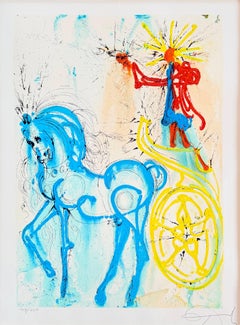Continental Europe - More Prints
to
304
745
364
519
97
79
Overall Width
to
Overall Height
to
491
291
210
209
46
31
3
3
3
2
2
2
138
120
54
50
48
12
24
1,508
260
3
3
15
33
40
195
405
391
195
86
2
1,375
335
91
9
6
5
4
3
2
2
2
1
1
1
1
1
1
1
1
1
1
1
815
348
292
167
120
39
820
1,804
3,835
3,651
Item Ships From: Continental Europe
Clavilegnio
By Salvador Dalí
Located in OPOLE, PL
This work will be exhibited at Art on Paper NYC, September 4–7, 2025.
–
Salvador Dali (1904-1989) - Clavilegnio
Lithograph from 1972.
The edition of 187/250.
Dimensions of work:...
Category
1970s Surrealist Continental Europe - More Prints
Materials
Lithograph
$6,608 Sale Price
20% Off
Daphnes and Chloé, Planche XLI
By Marc Chagall
Located in OPOLE, PL
Marc Chagall (1887-1985) - Daphnes and Chloé, Planche XLI
Lithograph from 1961.
Dimensions of work: 43 x 66 cm.
Enhanced with gouache. Examined and identified by a French gallery ...
Category
1930s Symbolist Continental Europe - More Prints
Materials
Lithograph
Anni Albers, ST - Original Screen Print from 1971, Geometric Abstraction
By Anni Albers
Located in Hamburg, DE
Anni Albers (1899-1994)
ST, 1971
Medium: Screenprint on cardboard
Dimensions: 83 × 62 cm (32 7/10 × 24 2/5 in)
Edition: Hand-signed and numbered in pencil
Condition: Very good
Category
20th Century Abstract Continental Europe - More Prints
Materials
Screen
Les Songes Drôlatiques de Pantagruel, Planche XIII
By Salvador Dalí
Located in OPOLE, PL
Salvador Dali (1904-1989) - Les Songes Drôlatiques de Pantagruel, Planche XIII
Lithograph from 1973.
Edition 6/250 on Japon paper.
Dimensions of work: 76 x 56 cm
Publisher: Carpe...
Category
1970s Surrealist Continental Europe - More Prints
Materials
Lithograph
Femme à le béquille
By Salvador Dalí
Located in OPOLE, PL
Salvador Dali (1904-1989) - Femme à le béquille
Etching from 1969.
66/145 on Japan paper.
Dimensions of work: 38 x 28.5 cm.
Hand signed.
Publisher: Graphik Europa Anstalt.
Refe...
Category
1960s Surrealist Continental Europe - More Prints
Materials
Etching
Le Cheval de Triomphe
By Salvador Dalí
Located in OPOLE, PL
Salvador Dali (1904-1989) - Le cheval de triomphe
Lithograph from 1970.
Edition of 187/254.
Dimensions of work: 68 x 50 cm
On B.F.K Rives paper as stated in the Field catalogue.
...
Category
1970s Surrealist Continental Europe - More Prints
Materials
Lithograph
Abstract Composition - Lithograph by André Masson - 1970s
By André Masson
Located in Roma, IT
Abstract Composition is an original colored lithograph realized in the half of XX century.
The artwork is hand signed on the lower right margin.
Numbered on the lower left. Edition...
Category
1970s Surrealist Continental Europe - More Prints
Materials
Lithograph
Marine Fauna, Blue and White, Bold Shapes, Figurative Seascape Element, Paper
By Kind of Cyan
Located in Barcelona, ES
This is an exclusive handprinted unique cyanotype that takes its inspiration from the mid-century modern shapes and the desert modernism movement.
It's made by layering paper cutouts...
Category
2010s Abstract Geometric Continental Europe - More Prints
Materials
Paper, Monotype
Filius Prodigus - Lithograph - 1964
By Salvador Dalí
Located in Roma, IT
Filius Prodigus is a Color lithograph on heavy rag paper realized in 1964. It is part of Biblia Sacra vulgatæ edition is published by Rizzoli-Mediolani between 1967 and 1969.
Signed...
Category
1960s Surrealist Continental Europe - More Prints
Materials
Lithograph
Virgo
By Salvador Dalí
Located in OPOLE, PL
Salvador Dali (1904-1989) - Virgo
Etching from 1974.
The edition HC IX/L on Guarro paper.
Dimensions of work: 35 x 26.2 cm.
Hand signed.
Publisher: Léon Amiel, Paris - New York....
Category
1970s Surrealist Continental Europe - More Prints
Materials
Etching
Marc Chagall - A Midsummer Night's dream - Original Handsigned Lithograph
By Marc Chagall
Located in Collonge Bellerive, Geneve, CH
Marc Chagall - A Midsummer Night's dream - Original Handsigned Lithograph
1975
Dimensions: Sheet : 97.5 x 71.5 cm Image : 80 x 60 cm
Handsigned and numbered
Edition: 50
Reference: ...
Category
1960s Surrealist Continental Europe - More Prints
Materials
Lithograph
Hommage à San Lazzaro
By Alexander Calder
Located in OPOLE, PL
This work will be exhibited at Art on Paper NYC, September 4–7, 2025.
–
Alexander Calder (1898-1976) - Hommage à San Lazzaro
Lithograph from 1975.
Edition 371/575 (Photocopy of t...
Category
1970s Modern Continental Europe - More Prints
Materials
Lithograph
$2,430 Sale Price
30% Off
The Bay of Angels
By Marc Chagall
Located in OPOLE, PL
Marc Chagall (1887-1985) - The Bay of Angels
Original Lithograph from 1960.
Dimensions of work: 32 x 24 cm.
Publisher: Maeght Éditeur, Paris.
The work is in Excellent condition.
Category
1960s Modern Continental Europe - More Prints
Materials
Lithograph
$680 Sale Price
36% Off
Nuit de Noël
By Henri Matisse
Located in OPOLE, PL
Henri Matisse (1869-1954) - Nuit de Noël
Lithograph from 1958.
Dimensions of work: 35.5 x 26.4 cm
Publisher: Tériade, Paris.
First, original edition.
The work is in Excellent co...
Category
1950s Surrealist Continental Europe - More Prints
Materials
Lithograph
La République
By Bernard Buffet
Located in OPOLE, PL
Bernard Buffet (1928-1999) - La République
Lithograph from 1977.
The edition of 103/150.
On Arches paper with watermark.
Dimensions of work: 76 x 56 cm.
Hand signed.
The work is...
Category
1970s Expressionist Continental Europe - More Prints
Materials
Lithograph
$2,394 Sale Price
20% Off
L'Air
By Joan Miró
Located in OPOLE, PL
Joan Miro (1893-1983) - L'Air
Lithograph from 1937.
Dimensions of work: 35 x 26 cm
Publisher: Tériade, Paris.
The work is in Excellent condition.
Fast and secure shipment.
Category
1930s Surrealist Continental Europe - More Prints
Materials
Lithograph
$1,500 Sale Price
30% Off
Carnets intimes de Braque XIII
By George Braque
Located in OPOLE, PL
Georges Braque (1882-1963) - Carnets intimes de Braque XIII
Lithograph from 1955.
Dimensions of work: 35 x 26 cm
Publisher: Tériade, Paris.
The work is in Excellent condition.
F...
Category
1950s Surrealist Continental Europe - More Prints
Materials
Lithograph
Cyclists - Silkscreen by Ugo Nespolo - 2008
Located in Roma, IT
This work is from the portfolio The Unique Collection for the Olympic Fine Arts 2008 presented during the Olympic Games and produced in 260 copies as the only official artistic produ...
Category
Early 2000s Pop Art Continental Europe - More Prints
Materials
Screen
Zao Wou-ki - Original Lithograph - Abstract Composition
By Zao Wou-Ki
Located in Collonge Bellerive, Geneve, CH
Zao Wou-ki - Original Lithograph
1962
From La tentation de l’Occident
Dimensions: 39 x 28.5 cm
Publisher: Les Bibliophiles Comtois
Edition of 170
Reference: Jørgen Ågerup 137 - 146...
Category
1960s Abstract Expressionist Continental Europe - More Prints
Materials
Lithograph
Horst Janssen Hand-Signed Poster 'München' Original Zinc Etching, 1967 — Framed
By Horst Janssen
Located in Barcelona, ES
Horst Janssen — Hand-Signed Poster “München (Galerie Wolfgang Ketterer, Villa Stuck)”, Original Zinc Etching, 1966–67 — Framed
Powerful hand-signed exhibition poster by Horst Jansse...
Category
1960s Abstract Continental Europe - More Prints
Materials
Paper
Femme Bleue
By Henri Matisse
Located in OPOLE, PL
Henri Matisse (1869-1954) - Femme Bleue
Lithograph from 1958.
Dimensions of work: 35.5 x 26.4 cm
Publisher: Tériade, Paris.
First, original edition.
The work is in Excellent con...
Category
1950s Surrealist Continental Europe - More Prints
Materials
Lithograph
$670 Sale Price
20% Off
Appolon
By Henri Matisse
Located in OPOLE, PL
Henri Matisse (1869-1954) - Appolon
Lithograph from 1958.
Dimensions of work: 52.5 x 35.5 cm.
Plate signed.
Publisher: Tériade, Paris.
Each copy of this Lithograph was originall...
Category
1950s Surrealist Continental Europe - More Prints
Materials
Lithograph
$957 Sale Price
20% Off
Decorative Motifs of Egyptian Renaissance - Chromolithograph -Early 20th Century
Located in Roma, IT
Decorative Motifs of the Egyptian Renaissance is a vintage chromolithograph by an anonymous artist.
Good conditions.
The artwork represents Decorative motifs of the Egyptian Renais...
Category
Early 20th Century Continental Europe - More Prints
Materials
Paper, Lithograph
Zao Wou-ki - Original Lithograph - Abstract Composition
By Zao Wou-Ki
Located in Collonge Bellerive, Geneve, CH
Zao Wou-ki - Lithograph
1971
Dimensions: 32 x 24 cm
Edition: G. di San Lazzaro.
From the art review XXe siècle
Unsigned and unnumbered as issued
Category
1970s Abstract Expressionist Continental Europe - More Prints
Materials
Lithograph
Luigi Ghirri - Vintage Poster After Luigi Ghirri - 1976
Located in Roma, IT
Luigi Ghirri is a vintage Poster realized in 1976.
The artwork is the poster for the artist's exhibition in Galleria Rondanini, Roma.
Category
1970s Contemporary Continental Europe - More Prints
Materials
Offset
Portfolio. Poèmes secrets d'Apollinaire
By Salvador Dalí
Located in OPOLE, PL
Salvador Dalí (1904–1989, Spain)
Portfolio: Poèmes secrets d'Apollinaire, 1967
Salvador Dalí’s Poèmes secrets d'Apollinaire (1967) is a mesmerizing portfolio of 10 drypoint etchings...
Category
1960s Surrealist Continental Europe - More Prints
Materials
Etching
Peintre et modèle au fume-cigarette
By Pablo Picasso
Located in OPOLE, PL
Pablo Picasso (1881-1973) - Peintre et modèle au fume-cigarette
Etching and aquatint from 1968.
The edition of 35/50.
Dimensions of work: 41.9 x 50.5 cm.
Hand signed.
Publisher:...
Category
1960s Modern Continental Europe - More Prints
Materials
Etching, Aquatint
Suite 347, 4 avril 1968, L. 16
By Pablo Picasso
Located in OPOLE, PL
Pablo Picasso (1881-1973) - Suite 347, 4 avril 1968, L. 16
Etching from 1968.
The edition of 30/50.
Dimensions of sheet: 45.5 x 56 cm
Dimensions in frame: 63 x 72 cm
Hand signed...
Category
1960s Modern Continental Europe - More Prints
Materials
Etching
De Petra Exivit Aqua - Lithograph - 1964
By Salvador Dalí
Located in Roma, IT
De Petra Exivit Aqua is a Color lithograph on heavy rag paper realized in 1964. It is part of Biblia Sacra vulgatæ edition is published by Rizzoli-Mediolani b...
Category
1960s Surrealist Continental Europe - More Prints
Materials
Lithograph
Structure VII - XX century, Abstract print, Colorful, Vibrant, Geometric
By Jan Pamula
Located in Warsaw, PL
JAN PAMUŁA (b. in 1944)
A Polish artist, professor of Academy of Fine Arts in Cracow. In 1961-1968 he studied painting and printmaking in Cracow. In 1967 he was studying in École nat...
Category
20th Century Other Art Style Continental Europe - More Prints
Materials
Paper, Color
1980s Signed Mario Schifano Artwork on Paper
By Mario Schifano
Located in Roma, IT
Materic silkscreen print “Ondate di gelo” (Frost Waves) by Mario Schifano.
Signature and numbering in pencil on front side.
Dry stamp of the artist on front.
Edition F.C. (Not for...
Category
1980s Modern Continental Europe - More Prints
Materials
Paper
$1,532 Sale Price
20% Off
La Ruse de Dorcon, from Daphnis et Chloé
By Marc Chagall
Located in OPOLE, PL
This work will be exhibited at Art on Paper NYC, September 4–7, 2025.
–-
Marc Chagall (1887-1985) - La Ruse de Dorcon, from Daphnis et Chloé
Lithograph from 1961.
The edition of...
Category
1960s Symbolist Continental Europe - More Prints
Materials
Lithograph
Untitled - Lithograph by Alexander Calder - Late 20th century
By Alexander Calder
Located in Roma, IT
Untitled is a Lithograph on paper realized in second half of the 20th Century by Alexander Calder.
Very good condition including a white cardboard passpartout (32 x 50 cm).
Alexand...
Category
Late 20th Century Contemporary Continental Europe - More Prints
Materials
Lithograph
Le cirque
By Marc Chagall
Located in OPOLE, PL
Marc Chagall (1887-1985) - Le cirque
Original Lithograph from 1960.
Dimensions of work: 32 x 24 cm.
Publisher: Maeght Éditeur, Paris.
The work is in Excellent condition.
Category
1960s Modern Continental Europe - More Prints
Materials
Lithograph
$681 Sale Price
36% Off
La Guillotine
By Bernard Buffet
Located in OPOLE, PL
Bernard Buffet (1928-1999) - La Guillotine
Lithograph from 1977.
The edition of 103/150.
On Arches paper with watermark.
Dimensions of work: 76 x 56 cm.
Hand signed.
The work is...
Category
1970s Expressionist Continental Europe - More Prints
Materials
Lithograph
Sainte Lucie
By Salvador Dalí
Located in OPOLE, PL
Salvador Dali (1904-1989) - Sainte Lucie
Etching and watercolour from 1974.
The edition 219/450.
Dimensions of work: 90 x 63.5 cm.
Hand signed.
Reference: Field, 73-3; Michler, ...
Category
1970s Modern Continental Europe - More Prints
Materials
Watercolor, Etching
Divine Comedy
By Salvador Dalí
Located in OPOLE, PL
Salvador Dalí’s Divine Comedy is a series of 100 color wood engravings, each corresponding to a canto from Dante Alighieri’s epic poem. Created between 1960 and 1964, these engraving...
Category
1970s Surrealist Continental Europe - More Prints
Materials
Woodcut
Cubist Portrait
By George Braque
Located in OPOLE, PL
Georges Braque (1882-1963) - Cubist Portrait
Lithograph from 1939.
Dimensions of work: 35 x 26 cm
Publisher: Tériade, Paris.
The work is in Excellent condition.
Fast and secure ...
Category
1930s Surrealist Continental Europe - More Prints
Materials
Lithograph
$909 Sale Price
20% Off
Sonia Delaunay - Composition - Original Lithograph
By Sonia Delaunay
Located in Collonge Bellerive, Geneve, CH
Sonia Delaunay - Composition
Original Lithograph
1972
Dimensions: 32 x 25 cm
Revue XXe Siècle
Cahiers d'art published under the direction of G. di San Lazzaro.
Sonia Delaunay was known for her vivid use of color and her bold, abstract patterns, breaking down traditional distinctions between the fine and applied arts as an artist, designer and printmaker.
Born Sarah Stern on November 14, 1885 in Gradizhsk, Ukraine, she was adopted in 1890 by her maternal uncle, Henri Terk, a lawyer in St. Petersburg, where she grew up, exposed to music and art, and learning several foreign languages. In 1903, she moved to Germany to study drawing with Ludwig Schmidt-Reutler (1863–1909) at the Karlsruhe academy of fine arts; Arnold Schoenberg (1874–1951), composer-to-be, was among her classmates there. In 1905, she traveled to Paris where she attended art classes at the Académie de la Palette, learned printmaking from Rudolf Grossman (1889–1941), and met Amédée Ozenfant (1886–1966), André Dunoyer de Segonzac (1884–1974), and Jean-Louis Boussingault (1883–1943). Sonia spent much of her time at exhibitions and galleries in Paris, which showed works by Paul Cézanne, Vincent Van Gogh, Pierre Bonnard, and Edouard Vuillard, as well as Les Fauves, Henri Matisse and André Derain. She did, however, maintain contact with Germany, exhibiting at the Galerie Der Sturm, Berlin, in 1913, 1920 and 1921.
During her first year in Paris, Sonia met the German collector and art-dealer, Wilhelm Uhde (1874–1947), whom she married on December 5, 1908, and whose Montparnasse gallery, the Galerie Notre-Dame des Champs, showed her first solo exhibition. Through Uhde, Sonia encountered many painters, including Pablo Picasso, Georges Braque, Maurice de Vlaminck, and Robert Delaunay (1885–1941). In 1910, Sonia divorced Uhde by mutual agreement, married Delaunay that same year, and gave birth to their son, Charles, in January 1911.
Together Sonia and Robert Delaunay pursued the study of color, influenced by theories of Michel-Eugène Chevreul (1786–1889). Sonia’s interest in simultaneous contrast, as evidenced in her early collages, book bindings, small painted boxes...
Category
1970s Abstract Geometric Continental Europe - More Prints
Materials
Lithograph
Baigneuse Dans Les Resaux
By Henri Matisse
Located in OPOLE, PL
Henri Matisse (1869-1954) - Baigneuse Dans Les Resaux
Lithograph from 1958.
Dimensions of work: 52.5 x 35.5 cm.
Publisher: Tériade, Paris.
Each copy of this Lithograph was origin...
Category
1950s Surrealist Continental Europe - More Prints
Materials
Lithograph
$957 Sale Price
20% Off
Espriu - Miró II
By Joan Miró
Located in OPOLE, PL
Joan Miro (1893-1983) - Espriu - Miró II
Etching and aquatint with carborundum from 1975.
The edition of 15/50 on on Guarro paper with Sala Gaspar watermark.
Dimensions of work: 70.3 x 85.7 cm.
Hand signed.
Publisher: Sala Gaspar, Barcelona.
Reference: Dupin 870; Cramer 197.
The work is in Good condition.
--
Joan Miró’s Espriu...
Category
1970s Surrealist Continental Europe - More Prints
Materials
Aquatint
Les Songes Drôlatiques de Pantagruel, Planche XV
By Salvador Dalí
Located in OPOLE, PL
Salvador Dali (1904-1989) - Les Songes Drôlatiques de Pantagruel, Planche XV
Lithograph from 1973.
Edition 6/250 on Japon paper.
Dimensions of work: 76 x 56 cm
Publisher: Carpent...
Category
1970s Surrealist Continental Europe - More Prints
Materials
Lithograph
Expo 1970 World Exhibition in Osaka – Original Vintage Japanese Poster
By Yusaku Kamekura
Located in Zurich, CH
Original Vintage Event Poster created 1967 by one of the best known Japanese graphic artists, Yusaku Kamekura; in 1960 he was a founding member, then ...
Category
Mid-20th Century Abstract Geometric Continental Europe - More Prints
Materials
Paper
Animam et Corpus Trado pro Patriis Legibus - Lithograph - 1964
By Salvador Dalí
Located in Roma, IT
Animam et Corpus Trado pro Patriis Legibus is a Color lithograph on heavy rag paper realized in 1964. It is part of Biblia Sacra vulgatæ edition is published by Rizzoli-Mediolani bet...
Category
1960s Surrealist Continental Europe - More Prints
Materials
Lithograph
Les Songes Drôlatiques de Pantagruel, Planche IV
By Salvador Dalí
Located in OPOLE, PL
Salvador Dali (1904-1989) - Les Songes Drôlatiques de Pantagruel, Planche IV
Lithograph from 1973.
Edition 6/250 on Japon paper.
Dimensions of work: 76 x 56 cm
Publisher: Carpent...
Category
1970s Surrealist Continental Europe - More Prints
Materials
Lithograph
Calder Exhibition Poster - Vintage Screen Print by Alexander Calder - 1976
By Alexander Calder
Located in Roma, IT
Calder Exhibition Poster is an artwork realized by Alexander Calder in 1976
Mixed colored serigraph.
Fair conditions with some tears along the margin.
This beautiful and colored p...
Category
1970s Contemporary Continental Europe - More Prints
Materials
Screen
Les Songes Drôlatiques de Pantagruel, Planche XVIII
By Salvador Dalí
Located in OPOLE, PL
Salvador Dali (1904-1989) - Les Songes Drôlatiques de Pantagruel, Planche XVIII
Lithograph from 1973.
Edition 6/250 on Japon paper.
Dimensions of work: 76 x 56 cm
Publisher: Carp...
Category
1970s Surrealist Continental Europe - More Prints
Materials
Lithograph
The House in my Village
By Marc Chagall
Located in OPOLE, PL
Marc Chagall (1887-1985) - The House in my Village
Original Lithograph from 1960.
Dimensions of work: 32 x 24 cm.
Publisher: Maeght Éditeur, Paris.
The work is in Excellent condi...
Category
1960s Modern Continental Europe - More Prints
Materials
Lithograph
$545 Sale Price
48% Off
L'Odyssée, Planche XIX
By Marc Chagall
Located in OPOLE, PL
Marc Chagall (1887–1985)
L'Odyssée, Planche XIX
Lithograph in colours, 1974,
A unique trial proof printed, notably without the central fold, with variant colouration differing from ...
Category
1970s Symbolist Continental Europe - More Prints
Materials
Lithograph
Femme Bleue
By Henri Matisse
Located in OPOLE, PL
Henri Matisse (1869-1954) - Femme Bleue
Lithograph from 1958.
Dimensions of work: 35.5 x 26.4 cm
Publisher: Tériade, Paris.
First, original edition.
The work is in Excellent con...
Category
1950s Surrealist Continental Europe - More Prints
Materials
Lithograph
$670 Sale Price
20% Off
And in those dayes, when Moses was growen... - The Exodus
By Marc Chagall
Located in OPOLE, PL
This work will be exhibited at Art on Paper NYC, September 4–7, 2025.
–-
Marc Chagall (1887-1985) - And in those dayes, when Moses was growen, he went foorth unto his brethren, and...
Category
1960s Symbolist Continental Europe - More Prints
Materials
Lithograph
$3,771 Sale Price
30% Off
Mestna Galerija Ljubljana - Photolithograph by Henry Moore - 1983
By Henry Moore
Located in Roma, IT
Vintage poster realized in occasion of Henry Moore's Exhibition in Mestna Galerija Ljubljana in 1983.
Photolihtograph.
Good condition.
Category
1980s Contemporary Continental Europe - More Prints
Materials
Lithograph
Peintre et sa toile avec modèle assis
By Pablo Picasso
Located in OPOLE, PL
Pablo Picasso (1881-1973) - Peintre et modèle, avec une sculpture I
Etching and aquatint from 1964.
The edition of 4/50.
Dimensions of work: 33 x 45 cm.
Hand signed.
Reference: ...
Category
1960s Modern Continental Europe - More Prints
Materials
Etching, Aquatint
Kandinsky's Exhibition Poster - Vintage Poster - Late 20th Century
By Wassily Kandinsky
Located in Roma, IT
Kandinsky's Exhibition Poster is a a vintage offset print realized in the late 20th Century.
An offset poster depicting one of the masterpiece of the artist.
Includes frame
Very g...
Category
1980s Modern Continental Europe - More Prints
Materials
Offset
$239 Sale Price
20% Off
Acrobats - Etching boy Marino Marini - 1963
By Marino Marini
Located in Roma, IT
Hand signed and numbered. Edition of 50 prints.
From the book "Idea e Spazio" including 12 etchings by Marino Marini and poems by Egle Marini.
Ref.: Toninelli n. 80.
Image dimensio...
Category
1960s Contemporary Continental Europe - More Prints
Materials
Etching
Marc Chagall - The Red Rider - Original Lithograph
By Marc Chagall
Located in Collonge Bellerive, Geneve, CH
Marc Chagall - Original Lithograph
The Red Rider
From the unsigned, unnumbered lithograph printed in the literary review XXe Siecle
1957
See Mourlot 191
Dimensions: 32 x 24 cm
Publisher: G. di San Lazzaro.
Marc Chagall (born in 1887)
Marc Chagall was born in Belarus in 1887 and developed an early interest in art. After studying painting, in 1907 he left Russia for Paris, where he lived in an artist colony on the city’s outskirts. Fusing his own personal, dreamlike imagery with hints of the fauvism and cubism popular in France at the time, Chagall created his most lasting work—including I and the Village (1911)—some of which would be featured in the Salon des Indépendants exhibitions. After returning to Vitebsk for a visit in 1914, the outbreak of WWI trapped Chagall in Russia. He returned to France in 1923 but was forced to flee the country and Nazi persecution during WWII. Finding asylum in the U.S., Chagall became involved in set and costume design before returning to France in 1948. In his later years, he experimented with new art forms and was commissioned to produce numerous large-scale works. Chagall died in St.-Paul-de-Vence in 1985.
The Village
Marc Chagall was born in a small Hassidic community on the outskirts of Vitebsk, Belarus, on July 7, 1887. His father was a fishmonger, and his mother ran a small sundries shop in the village. As a child, Chagall attended the Jewish elementary school, where he studied Hebrew and the Bible, before later attending the Russian public school. He began to learn the fundamentals of drawing during this time, but perhaps more importantly, he absorbed the world around him, storing away the imagery and themes that would feature largely in most of his later work.
At age 19 Chagall enrolled at a private, all-Jewish art school and began his formal education in painting, studying briefly with portrait artist Yehuda Pen. However, he left the school after several months, moving to St. Petersburg in 1907 to study at the Imperial Society for the Protection of Fine Arts. The following year, he enrolled at the Svanseva School, studying with set designer Léon Bakst, whose work had been featured in Sergei Diaghilev's Ballets Russes. This early experience would prove important to Chagall’s later career as well.
Despite this formal instruction, and the widespread popularity of realism in Russia at the time, Chagall was already establishing his own personal style, which featured a more dreamlike unreality and the people, places and imagery that were close to his heart. Some examples from this period are his Window Vitebsk (1908) and My Fianceé with Black Gloves (1909), which pictured Bella Rosenfeld, to whom he had recently become engaged.
The Beehive
Despite his romance with Bella, in 1911 an allowance from Russian parliament member and art patron Maxim Binaver enabled Chagall to move to Paris, France. After settling briefly in the Montparnasse neighborhood, Chagall moved further afield to an artist colony known as La Ruche (“The Beehive”), where he began to work side by side with abstract painters such as Amedeo Modigliani and Fernand Léger as well as the avant-garde poet Guillaume Apollinaire. At their urging, and under the influence of the wildly popular fauvism and cubism, Chagall lightened his palette and pushed his style ever further from reality. I and the Village (1911) and Homage to Apollinaire (1912) are among his early Parisian works, widely considered to be his most successful and representative period.
Though his work stood stylistically apart from his cubist contemporaries, from 1912 to 1914 Chagall exhibited several paintings at the annual Salon des Indépendants exhibition, where works by the likes of Juan Gris, Marcel Duchamp and Robert Delaunay were causing a stir in the Paris art world. Chagall’s popularity began to spread beyond La Ruche, and in May 1914 he traveled to Berlin to help organize his first solo exhibition, at Der Sturm Gallery. Chagall remained in the city until the highly acclaimed show opened that June. He then returned to Vitebsk, unaware of the fateful events to come.
War, Peace and Revolution
In August 1914 the outbreak of World War I precluded Chagall’s plans to return to Paris. The conflict did little to stem the flow of his creative output, however, instead merely giving him direct access to the childhood scenes so essential to his work, as seen in paintings such as Jew in Green (1914) and Over Vitebsk (1914). His paintings from this period also occasionally featured images of the war’s impact on the region, as with Wounded Soldier (1914) and Marching (1915). But despite the hardships of life during wartime, this would also prove to be a joyful period for Chagall. In July 1915 he married Bella, and she gave birth to a daughter, Ida, the following year. Their appearance in works such as Birthday (1915), Bella and Ida by the Window (1917) and several of his “Lovers” paintings give a glimpse of the island of domestic bliss that was Chagall’s amidst the chaos.
To avoid military service and stay with his new family, Chagall took a position as a clerk in the Ministry of War Economy in St. Petersburg. While there he began work on his autobiography and also immersed himself in the local art scene, befriending novelist Boris Pasternak, among others. He also exhibited his work in the city and soon gained considerable recognition. That notoriety would prove important in the aftermath of the 1917 Russian Revolution when he was appointed as the Commissar of Fine Arts in Vitebsk. In his new post, Chagall undertook various projects in the region, including the 1919 founding of the Academy of the Arts. Despite these endeavors, differences among his colleagues eventually disillusioned Chagall. In 1920 he relinquished his position and moved his family to Moscow, the post-revolution capital of Russia.
In Moscow, Chagall was soon commissioned to create sets and costumes for various productions at the Moscow State Yiddish Theater, where he would paint a series of murals titled Introduction to the Jewish Theater as well. In 1921, Chagall also found work as a teacher at a school for war orphans. By 1922, however, Chagall found that his art had fallen out of favor, and seeking new horizons he left Russia for good.
Flight
After a brief stay in Berlin, where he unsuccessfully sought to recover the work exhibited at Der Sturm before the war, Chagall moved his family to Paris in September 1923. Shortly after their arrival, he was commissioned by art dealer and publisher Ambroise Vollard to produce a series of etchings for a new edition of Nikolai Gogol's 1842 novel Dead Souls. Two years later Chagall began work on an illustrated edition of Jean de la Fontaine’s Fables, and in 1930 he created etchings for an illustrated edition of the Old Testament, for which he traveled to Palestine to conduct research.
Chagall’s work during this period brought him new success as an artist and enabled him to travel throughout Europe in the 1930s. He also published his autobiography, My Life (1931), and in 1933 received a retrospective at the Kunsthalle in Basel, Switzerland. But at the same time that Chagall’s popularity was spreading, so, too, was the threat of Fascism and Nazism. Singled out during the cultural "cleansing" undertaken by the Nazis in Germany, Chagall’s work was ordered removed from museums throughout the country. Several pieces were subsequently burned, and others were featured in a 1937 exhibition of “degenerate art” held in Munich. Chagall’s angst regarding these troubling events and the persecution of Jews in general can be seen in his 1938 painting White Crucifixion.
With the eruption of World War II, Chagall and his family moved to the Loire region before moving farther south to Marseilles following the invasion of France. They found a more certain refuge when, in 1941, Chagall’s name was added by the director of the Museum of Modern Art (MOMA) in New York City to a list of artists and intellectuals deemed most at risk from the Nazis’ anti-Jewish campaign. Chagall and his family would be among the more than 2,000 who received visas and escaped this way.
Haunted Harbors
Arriving in New York City in June 1941, Chagall discovered that he was already a well-known artist there and, despite a language barrier, soon became a part of the exiled European artist community. The following year he was commissioned by choreographer Léonide Massine to design sets and costumes for the ballet Aleko, based on Alexander Pushkin’s “The Gypsies” and set to the music of Pyotr Ilyich Tchaikovsky.
But even as he settled into the safety of his temporary home, Chagall’s thoughts were frequently consumed by the fate befalling the Jews of Europe and the destruction of Russia, as paintings such as The Yellow Crucifixion...
Category
1950s Surrealist Continental Europe - More Prints
Materials
Lithograph
Le Po au Lait - Original Etching by Félicien Rops - Late 19th Century
By Félicien Rops
Located in Roma, IT
Le Pot au Lait is a beautiful and rare engraving of the second half of the XIX century, realized with different techniques by the Belgian artist Felicien Rops. This is a Last State a...
Category
Late 19th Century Symbolist Continental Europe - More Prints
Materials
Etching
Pablo Picasso (after) Helene Chez Archimede - Wood Engraving
By (after) Pablo Picasso
Located in Collonge Bellerive, Geneve, CH
Pablo Picasso (after)
Helene Chez Archimede
Medium: engraved on wood by Georges Aubert
Dimensions: 44 x 33 cm
Portfolio: Helen Chez Archimede
Year: 1955
Edition: 240 (Here it is on...
Category
1950s Modern Continental Europe - More Prints
Materials
Wood, Archival Paper, Engraving
Georg Baselitz, Serpentine (Blue): Signed etching with sugar lift aquatint
By Georg Baselitz
Located in Hamburg, DE
Georg Baselitz (German, b. 1938)
Serpentine (Blue), 2022
Medium: Etching with sugar lift aquatint on wove paper
Dimensions: 53 × 39 cm (20 9/10 × 15 2/5 in)
Edition of 50: Hand-signe...
Category
21st Century and Contemporary Neo-Expressionist Continental Europe - More Prints
Materials
Etching, Aquatint
The Celestial Staircase - Woodcut print - 1963
By Salvador Dalí
Located in Roma, IT
The Celestial Staircase from the Series "The Divine Comedy" by Dante Alighieri is an woodcut print realized in 1963.
Good conditions. Not signed.
Plate n.21 (as reported on the ba...
Category
1960s Surrealist Continental Europe - More Prints
Materials
Woodcut
Still Thinking About These?
All Recently ViewedMore Ways To Browse
Mordechai Rosenstein
Murakami Flowers Blooming In This World
Oranges By Donald Sultan
Picasso Bullring
Porsche 904
R And B Vintage Radio
R W Smith
Richard Sedlon
Roy Lichtenstein Sweet Dreams
Salvador Dali Signed 1975
Sandra Gamarra
Schnabel Poster
Seattle Worlds Fair Poster
Shelby And Sandy
Shepard Fairey Love Lotus
Shinduk Kang
Snoopy Tennis
Sorrento Vintage Poster
